It’s Wednesday morning and we just had the most amazing sunrise. I have to open with a shot of what the sky looked like from behind Pandora. 
The last two days took us from Newport News where we entered the Dismal Swamp Canal for what was one of the most lovely stretches of water that Brenda and I have ever experienced. The 22 canal, or cut, was dug completely using hand labor, mostly by slaves. It took 12 years to dig and finally opened in 1805. Clearly there were excellent surveyors involved as it is amazingly straight with only a single bend in it’s entire length.
Pandora’s draft of 6′ is nearly to the limit of the canal and we had heard horror stories of boats hitting submerged logs, sometimes hard hits, as they passed through. We had also heard that it was the most beautiful part of the ICW so we ignored the nay-sayers and decided to go anyway. WHAT AN AMAZING TRIP!!!. So amazing that Brenda claimed that it was the pinacle of her boating life. Hmm… Perhaps it was the still waters and utter lack of wind in the canal. And about those logs, I am happy to report that we didn’t hit one beyond a few very light bumps (if you could even detect them at all) along the entire stretch. We just loved it. We were told that the Army Corps had recently dragged for logs over a several week period and had taken out tons of stumps and logs from the water. I think that the lady at the visitor’s center said 180 tons but am not sure. One way or the other, it was a lot and we could see ample evidence of their work at various points where there were piles of muddy stumps and trees piled up on the sides of the canal.
At one point we even had a turkey fly in front of the boat from one side to the other. Oh yea, did I mention that the entire width of the canal is only 50′. It’s really narrow and you have to stay in the very center of the cut to avoid hitting the mast on overhanging trees.
It was amazing to see how the vegetation changed from Newport News to the southern end of the canal in Elizabeth City where we are now. Here is much more “southern” looking with much more Bald Cypress trees and a lot less of the deciduous trees like maple that we are used to. Actually, Bald Cypress are called that because they loose their needles in the winter. These trees are the type of swamp trees that seem to typify the south in movies. They are the ones with the knees that stick up out of the water all around the main trunk. It seems that the knees help the roots get oxygen. This photo shows the enlarged trunk base that is so typical of the tree types here. 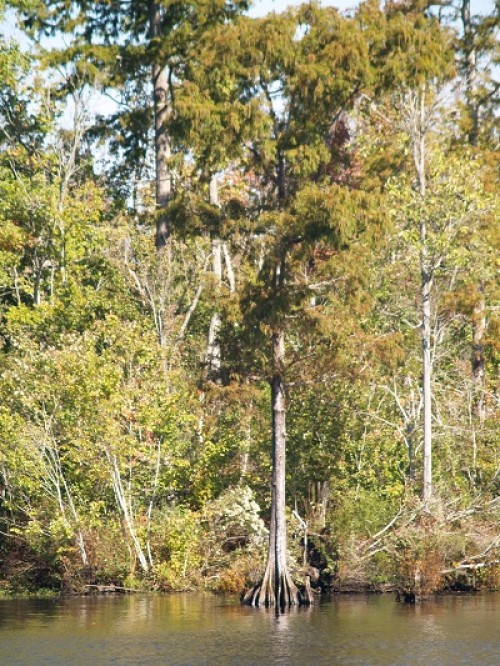 It’s hard to describe just how narrow the canal is, and how completely straight. It’s amazing just how rail straight it really is. Actually, this photo makes it look wider than it really is.
It’s hard to describe just how narrow the canal is, and how completely straight. It’s amazing just how rail straight it really is. Actually, this photo makes it look wider than it really is. 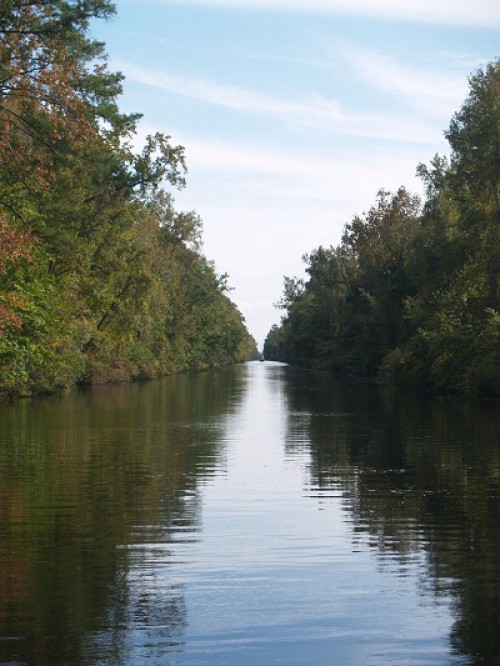 In order to keep the water level at a reasonable level in the swamp and canal, you have to be raised up in a lock at each end about 5-8 feet, it might have been more, to the level of the swamp to make the trip.
In order to keep the water level at a reasonable level in the swamp and canal, you have to be raised up in a lock at each end about 5-8 feet, it might have been more, to the level of the swamp to make the trip.
Brenda was totally anxious about going through the two locks as she was imagining the swirling water entering the lock and slamming us against the sides as the some one million gallons of water came in and filled the lock. Happily, Brenda actually enjoyed the locking process. Perhaps it was the “nurturing” lockmaster Robert who talked us through the entire process that made it so enjoyable. Robert is a very nice guy and he asked us to bring him a conch shell on our trip back north in the spring. Actually by the look of the pile of shells on the side of the lock, Robert has plenty already but we will certainly bring him one when we return. When we rose up in the lock here is the little garden that we were able to see, complete with conch shells. Actually, this photo doesn’t begin to show the dozens, if not hundreds that have been given to him by passing boaters. 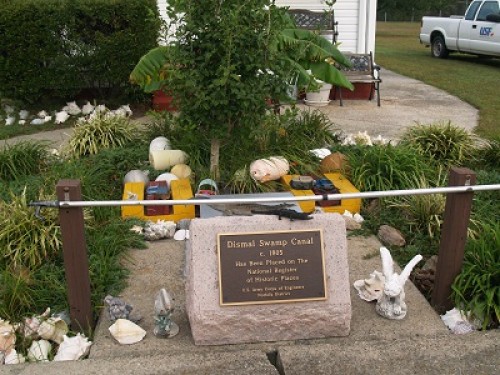 Doesn’t Robert look the part of the nurturing lock master? The guy at the south lock was nice enough but he was no Robert. No conch shells for him.
Doesn’t Robert look the part of the nurturing lock master? The guy at the south lock was nice enough but he was no Robert. No conch shells for him. 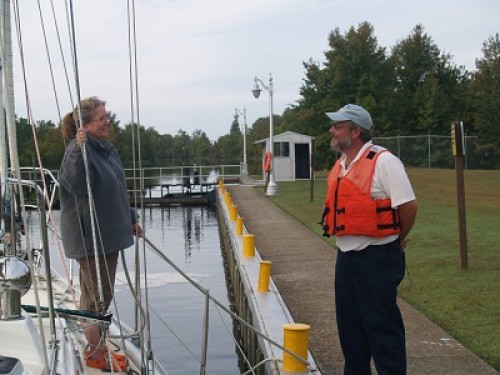 Notice how high the water is in the lock in the above picture compared to this one. It’s a pretty good rise. The water really swirls in quickly and Robert said that he was being easy on us by not letting the water in even faster.
Notice how high the water is in the lock in the above picture compared to this one. It’s a pretty good rise. The water really swirls in quickly and Robert said that he was being easy on us by not letting the water in even faster. 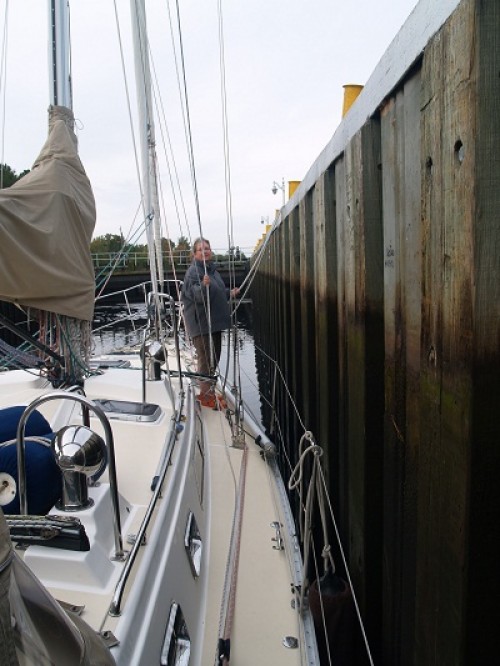 About half way through the canal you leave Virginia and enter North Carolina. It was funny to see this sign driven into the canal bottom. The other side says “welcome to Virginia”. Funny thing.
About half way through the canal you leave Virginia and enter North Carolina. It was funny to see this sign driven into the canal bottom. The other side says “welcome to Virginia”. Funny thing.
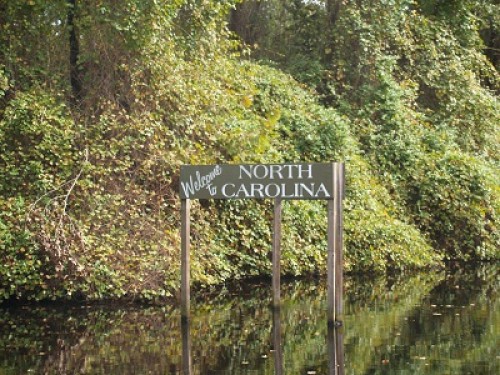 Another aspect of the ICW is that distances are listed in statute or land miles as opposed to nautical miles. A statute mile is a bit shorter by about 10% compared to a nautical mile. As you head south you see mile markers so you can keep track of where you are. Otherwise, as much of it looks the same, you might get confused. There was one of these every mile in the canal.
Another aspect of the ICW is that distances are listed in statute or land miles as opposed to nautical miles. A statute mile is a bit shorter by about 10% compared to a nautical mile. As you head south you see mile markers so you can keep track of where you are. Otherwise, as much of it looks the same, you might get confused. There was one of these every mile in the canal. 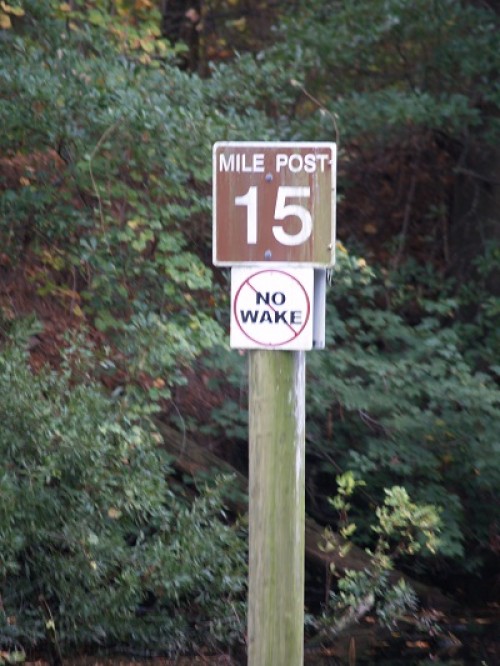 An interesting feature of the canal is that there is a large farm that straddles both sides and in order to get livestock from one side to the other, there is a manually operated bridge that the farmer uses to get his charges across to the other fields. The guide book says that you need to be patient if it’s closed as it takes time to get cows to the other side. This has to be a one of a kind bridge for sure.
An interesting feature of the canal is that there is a large farm that straddles both sides and in order to get livestock from one side to the other, there is a manually operated bridge that the farmer uses to get his charges across to the other fields. The guide book says that you need to be patient if it’s closed as it takes time to get cows to the other side. This has to be a one of a kind bridge for sure.
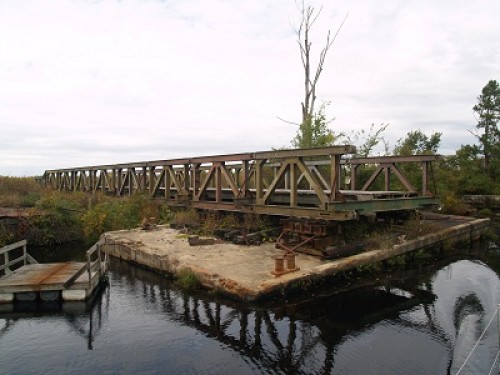 The surrounding trees leach tannins into the water and color it a rich brown. It’s not muddy, just brown. Some say that it looks like strong tea but to me it’s more like strong coffee but without milk. To see this dark stuff run up around the bow was fun to watch. Boats on the ICW end up with a distinctive “moustache” from the discoloration near the waterline from the tannins.
The surrounding trees leach tannins into the water and color it a rich brown. It’s not muddy, just brown. Some say that it looks like strong tea but to me it’s more like strong coffee but without milk. To see this dark stuff run up around the bow was fun to watch. Boats on the ICW end up with a distinctive “moustache” from the discoloration near the waterline from the tannins. 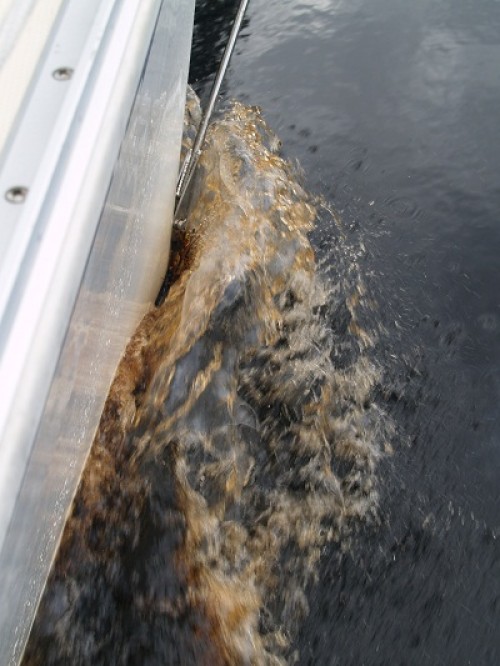 After exiting the south lock we entered a winding river that lead to Elizabeth City, our destination for the day. This portion of the trip was nearly as narrow as the canal but even more scenic, if that was possible. Around each curve, and there were plenty of curves, the view was more beautiful. The water was still except for our wake and the river were covered with duck weed which parted in swirls as we passed.
After exiting the south lock we entered a winding river that lead to Elizabeth City, our destination for the day. This portion of the trip was nearly as narrow as the canal but even more scenic, if that was possible. Around each curve, and there were plenty of curves, the view was more beautiful. The water was still except for our wake and the river were covered with duck weed which parted in swirls as we passed.
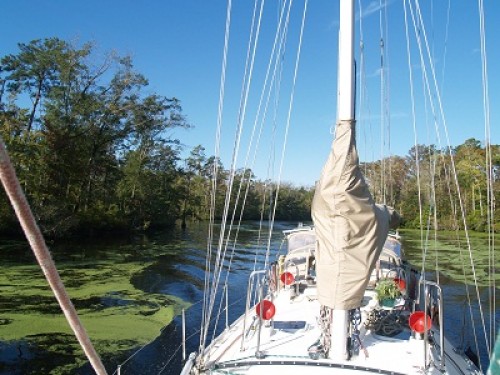 Elizabeth City saw it’s heyday when the canal was in full swing as a shipping center for lumber cut in the swamp. Cedar shingles were the major export. Now it’s boaters that bring cash to the city as some 1,800 of them stop here on their trips north or south each year. In order to encourage visitors, the city offers free dockage for two nights if you want to stop. The city is also known for their “Rosebuddies” a group of retired men who greet visitors each evening and host a wine and cheese reception at any time that there are 5 or more boats on the docks. They even, and this is the best part, hand out a rose to each female visitor that arrives by boat. Now that the founder of this tradition has passed away, the visitor’s bureau continues the tradition.
Elizabeth City saw it’s heyday when the canal was in full swing as a shipping center for lumber cut in the swamp. Cedar shingles were the major export. Now it’s boaters that bring cash to the city as some 1,800 of them stop here on their trips north or south each year. In order to encourage visitors, the city offers free dockage for two nights if you want to stop. The city is also known for their “Rosebuddies” a group of retired men who greet visitors each evening and host a wine and cheese reception at any time that there are 5 or more boats on the docks. They even, and this is the best part, hand out a rose to each female visitor that arrives by boat. Now that the founder of this tradition has passed away, the visitor’s bureau continues the tradition.
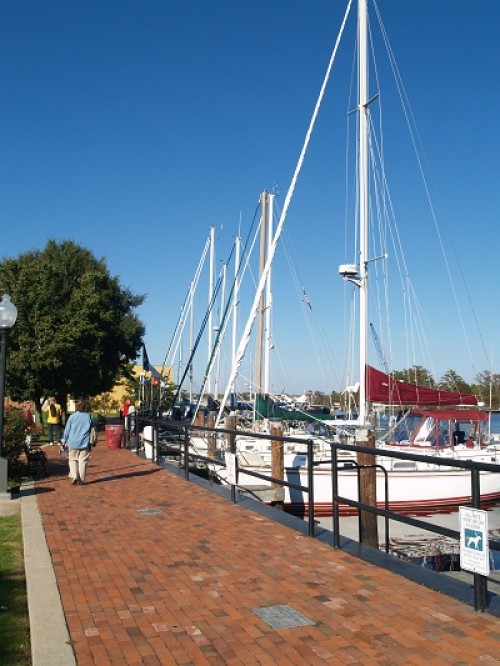 The gentleman, and a real southern gentleman at that, on the left is one of the “rosebuddies” and he continues to participate as he is able. The guy on the right is the past mayor of Elizabeth City. It seems that he quit the mayor thing to go cruising. Good choice. He made a very nice “pitch” for the city and why we should come here again. What a fun event. This will not be our last visit. Actually, this may be the very first recommendation on where to stop that we heard about when we began asking folks about the trip south. They all said that we had to visit so Brenda could get a rose.
The gentleman, and a real southern gentleman at that, on the left is one of the “rosebuddies” and he continues to participate as he is able. The guy on the right is the past mayor of Elizabeth City. It seems that he quit the mayor thing to go cruising. Good choice. He made a very nice “pitch” for the city and why we should come here again. What a fun event. This will not be our last visit. Actually, this may be the very first recommendation on where to stop that we heard about when we began asking folks about the trip south. They all said that we had to visit so Brenda could get a rose. 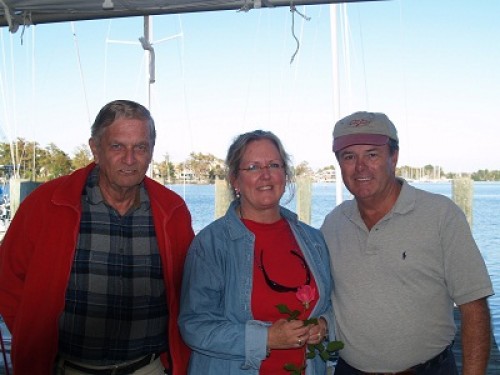 The heyday of he canal must have been pretty amazing judging by the local homes. How about this one? I hear that there is a women in her 90s that lives here alone. She is the daughter (granddaughter) of the first owner. It’s probably the best home in the area.
The heyday of he canal must have been pretty amazing judging by the local homes. How about this one? I hear that there is a women in her 90s that lives here alone. She is the daughter (granddaughter) of the first owner. It’s probably the best home in the area. 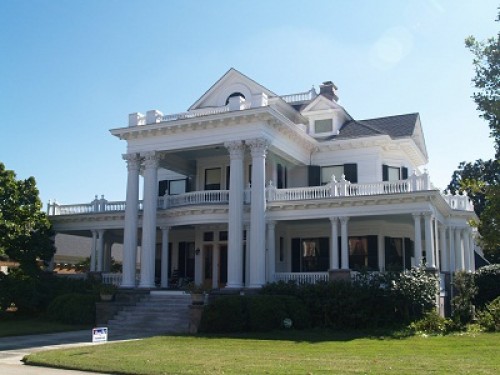 This home has been turned into a spa but it’s still well maintained.
This home has been turned into a spa but it’s still well maintained. 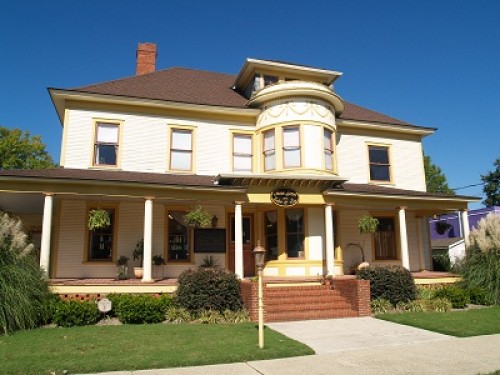 This morning, if I ever finish this post, we are headed to the local museum, the Museum of the Alermarle which chronicles the history of the area. The building is really large for such a small city. I am looking forward to seeing what’s there. After that, who knows, perhaps off to the Alligator River, perhaps another night on the dock. Alligator River? That sounds really southern doesn’t it? They say that there aren’t any alligators there these days but there are bears. I can’t wait.
This morning, if I ever finish this post, we are headed to the local museum, the Museum of the Alermarle which chronicles the history of the area. The building is really large for such a small city. I am looking forward to seeing what’s there. After that, who knows, perhaps off to the Alligator River, perhaps another night on the dock. Alligator River? That sounds really southern doesn’t it? They say that there aren’t any alligators there these days but there are bears. I can’t wait.

One response to “A not so Dismal Swamp and a health dose of southern hospitality.”